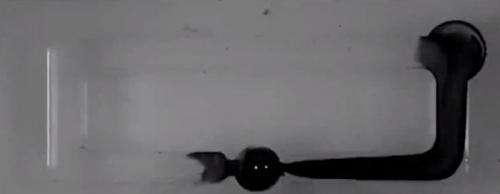Liquid metal pump a breakthrough for micro-fluidics

RMIT University researchers in Melbourne, Australia, have developed the world's first liquid metal enabled pump, a revolutionary new micro-scale device with no mechanical parts.
The unique design will enable micro-fluidics and lab-on-a-chip technology to finally realise their potential, with applications ranging from biomedicine to biofuels.
The research has been published this week in Proceedings of the National Academy of Sciences (PNAS).
Lead investigator Dr Khashayar Khoshmanesh, a Research Fellow in the Centre for Advanced Electronics and Sensors at RMIT, said currently there was no easy way to drive liquid around a fluidic chip in micro-fabricated systems.
"Lab-on-a-chip systems hold great promise for applications such as biosensing and blood analysis but they currently rely on cumbersome, large-scale external pumps, which significantly limit design possibilities," he said.
"Our unique pump enabled by a single droplet of liquid metal can be easily integrated into a micro device, has no mechanical parts and is both energy efficient and easy to produce or replace.
"Just as integrated micro-electronics has revolutionised the way that we process information – enabling the development of computers and smart phones – integrated micro-fluidics has the potential to revolutionise the way we process chemicals and manipulate bio-particles at the micro-scale.
"This innovation shows that micro- and nano-scale pumping can be accomplished with a simple system – a crucial advance for the field of micro-fluidics."
The design uses droplets of Galinstan – a non-toxic liquid metal alloy comprised of gallium, indium and tin – as the core of a pumping system to induce flows of liquid in looped channels.
When the alloy is activated by applying a voltage, the charge distribution along the surface is altered. This propels the surrounding liquid without moving the Galinstan droplet through the loop, using a process called "continuous electrowetting".
The pump is highly controllable, with the flow rate adjusted simply by altering the frequency, magnitude and waveform of the applied signal. The flow direction can also be readily reversed by reversing the polarity of the applied voltage.
More information: Shi-Yang Tang, Khashayar Khoshmanesh, Vijay Sivan, Phred Petersen, Anthony P. O'Mullane, Derek Abbott, Arnan Mitchell, and Kourosh Kalantar-zadeh. "Liquid metal enabled pump." PNAS 2014 ; published ahead of print February 18, 2014, DOI: 10.1073/pnas.1319878111
Journal information: Proceedings of the National Academy of Sciences
Provided by RMIT University



















